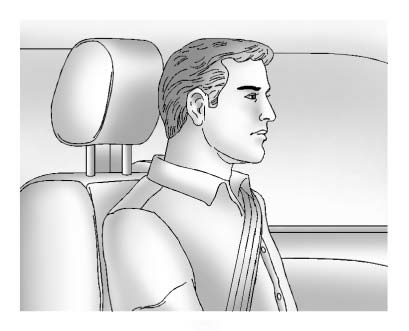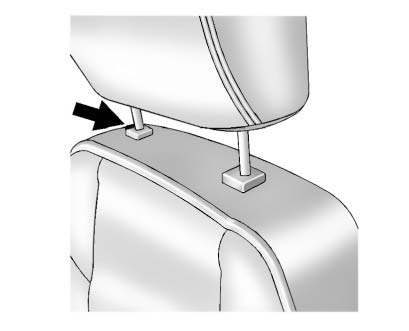Chevrolet Cruze Owners Manual: Head Restraints
The vehicle's front and rear seats have adjustable head restraints in the outboard seating positions.
WARNING
With head restraints that are not installed and adjusted properly, there is a greater chance that occupants will suffer a neck/ spinal injury in a crash. Do not drive until the head restraints for all occupants are installed and adjusted properly.

Adjust the head restraint so that the top of the restraint is at the same height as the top of the occupant's head. This position reduces the chance of a neck injury in a crash.

The height of the head restraint can be adjusted. Pull the head restraint up to raise it. Try to move the head restraint to make sure that it is locked in place.
To lower the head restraint, press the button, located on the top of the seatback, and push the head restraint down. Try to move the head restraint after the button is released to make sure that it is locked in place.
The front seat outboard head restraints are not designed to be removed.
 Front Seats
Front Seats
...
Other materials:
Ultrasonic Parking Assist
The Ultrasonic Rear Parking Assist (URPA) system assists the driver with parking
and avoiding objects while in R (Reverse). URPA operates at speeds less than 8 km/h
(5 mph). The sensors on the rear bumper detect objects up to 2.5m (8 ft) behind
the vehicle, and at least 20 cm (8 in) off the gr ...
Power Steering Fluid Reservoir Replacement
Preliminary Procedure
Remove as much power steering fluid from the remote power steering fluid
reservoir as possible.
Place drain pans under the vehicle as needed.
Hose Clamp
Procedure
Compress the power steering fluid reservoir outlet and inlet hose clamp
from the power ...
Instrument Panel Accessory Bezel Replacement
Preliminary Procedure
Remove transmission control cover. Refer to Automatic or Manual Transmission
Control Lever Trim Cover Replacement.
Instrument Panel Accessory Bezel Screw (Qty: 4)
Caution: Refer to Fastener Caution in the Preface section.
Tighten
2.5 N·m (23 lb in).
Instrume ...

